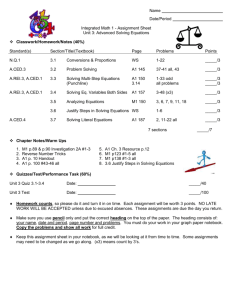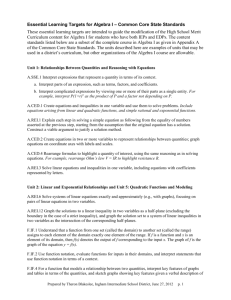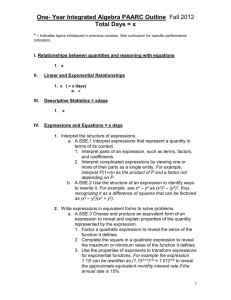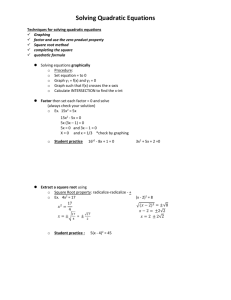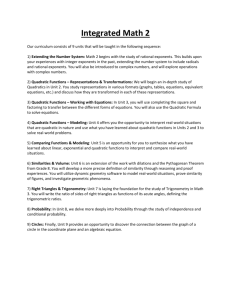Mathematics II Outcomes and Targets 2015-2016
advertisement
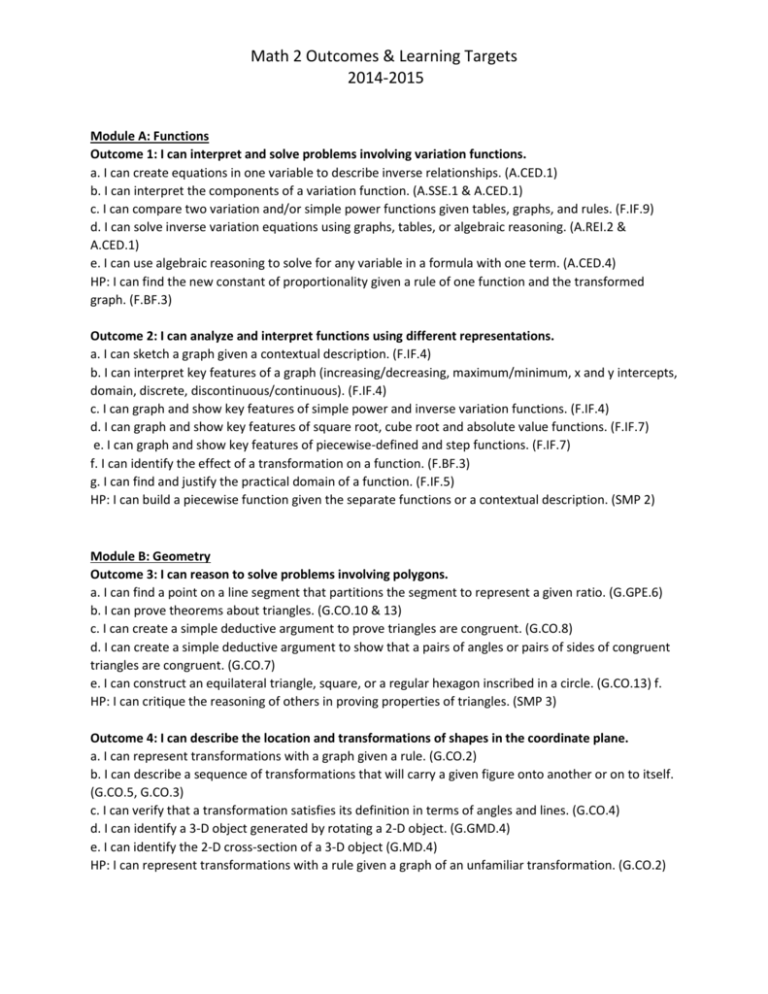
Math 2 Outcomes & Learning Targets 2014-2015 Module A: Functions Outcome 1: I can interpret and solve problems involving variation functions. a. I can create equations in one variable to describe inverse relationships. (A.CED.1) b. I can interpret the components of a variation function. (A.SSE.1 & A.CED.1) c. I can compare two variation and/or simple power functions given tables, graphs, and rules. (F.IF.9) d. I can solve inverse variation equations using graphs, tables, or algebraic reasoning. (A.REI.2 & A.CED.1) e. I can use algebraic reasoning to solve for any variable in a formula with one term. (A.CED.4) HP: I can find the new constant of proportionality given a rule of one function and the transformed graph. (F.BF.3) Outcome 2: I can analyze and interpret functions using different representations. a. I can sketch a graph given a contextual description. (F.IF.4) b. I can interpret key features of a graph (increasing/decreasing, maximum/minimum, x and y intercepts, domain, discrete, discontinuous/continuous). (F.IF.4) c. I can graph and show key features of simple power and inverse variation functions. (F.IF.4) d. I can graph and show key features of square root, cube root and absolute value functions. (F.IF.7) e. I can graph and show key features of piecewise-defined and step functions. (F.IF.7) f. I can identify the effect of a transformation on a function. (F.BF.3) g. I can find and justify the practical domain of a function. (F.IF.5) HP: I can build a piecewise function given the separate functions or a contextual description. (SMP 2) Module B: Geometry Outcome 3: I can reason to solve problems involving polygons. a. I can find a point on a line segment that partitions the segment to represent a given ratio. (G.GPE.6) b. I can prove theorems about triangles. (G.CO.10 & 13) c. I can create a simple deductive argument to prove triangles are congruent. (G.CO.8) d. I can create a simple deductive argument to show that a pairs of angles or pairs of sides of congruent triangles are congruent. (G.CO.7) e. I can construct an equilateral triangle, square, or a regular hexagon inscribed in a circle. (G.CO.13) f. HP: I can critique the reasoning of others in proving properties of triangles. (SMP 3) Outcome 4: I can describe the location and transformations of shapes in the coordinate plane. a. I can represent transformations with a graph given a rule. (G.CO.2) b. I can describe a sequence of transformations that will carry a given figure onto another or on to itself. (G.CO.5, G.CO.3) c. I can verify that a transformation satisfies its definition in terms of angles and lines. (G.CO.4) d. I can identify a 3-D object generated by rotating a 2-D object. (G.GMD.4) e. I can identify the 2-D cross-section of a 3-D object (G.MD.4) HP: I can represent transformations with a rule given a graph of an unfamiliar transformation. (G.CO.2) Math 2 Outcomes & Learning Targets 2014-2015 Module C: Quadratic Functions Outcome 5: I can use the structure of a quadratic to analyze quadratic functions. a. I can use the structure of an expression to rewrite the expression in factored form, when possible. (A.SSE.2) b. I can identify the key features (y-intercept, zeroes, axis of symmetry, minimum/maximum, and even/odd/neither) of a quadratic function. (A.APR.3, F.IF.8, F.BF.3) c. I can factor a quadratic function and use the factored form to sketch a graph. (A.APR.3, F.IF.8) HP: I can write a quadratic function given the key features of a graph. (F.BF) Outcome 6: I can solve quadratic equations. a. I can solve quadratic equations by inspection. (A.REI.4) b. I can rewrite and solve quadratic equations using factored form. (A.SSE.2, A.REI.4) c. I can use square roots to solve quadratic equations. (A.REI.4) d. I can use the quadratic formula to solve quadratic equations. (A.REI.4) HP: I can determine and justify if a quadratic equation has no real solutions. (A.REI.4) Outcome 7: I can reason with algebraic expressions and functions. a. I can write a function that describes the relationship between two quantities. (F.BF.1a) b. I can write a recursive rule that describes the relationship between two quantities. (F.BF.1a) c. I can add, subtract and multiply polynomials and justify that the result is also a polynomial. (A.APR.1) d. I can build a function by combining two or more other functions to model a relationship between two quantities. (F.BF.1b) e. I can use, evaluate and interpret statements that use function notation. (F.IF.2) HP: I can describe a situation that relates two or more functions together to represent a given function. (F.BF) Module D: Probability Outcome 8: I can determine independent and conditional probabilities a. I can define a subset of a sample space for a given situation. (S.CP.1) b. I can construct and interpret a two-way frequency table. (S.CP.4) c. I can determine the probability of events including “and”, “or”, and “not”. (S.CP.1, S.CP.7, S.CP.8+) d. I can determine the conditional probability of an event given another event has occurred. (S.CP.4, S.CP.5, S.CP.6) HP: I can use calculations with conditional probability to justify if two events are independent. (S.CP) Outcome 9: I can use probabilities to interpret data. a. I can evaluate and validate the results from experiments, studies, or surveys. (S.IC.2, S.IC.6) b. I can reason to determine if two events are independent. (S.CP.2, S.CP.4, S.CP. 5) c. I can explain conditional probability and independence in everyday language and everyday situations. (S.CP.5) HP: I can use calculations with the Multiplication Rule for Independent Events to justify if two events are independent. (S.CP.2, S.CP.3) Math 2 Outcomes & Learning Targets 2014-2015 Module E: Trigonometry Outcome 10: I can reason and solve problems involving right triangles. a. I can write the equation of a circle given the center and radius. (G.GPE.1) b. I can define and use trigonometric ratios to solve problems (G.SRT.6, G.SRT.8, A.CED.2) c. I can graph simple trigonometric functions (0° to 180°) and show key features (intervals of increase, decrease, positive, or negative, and domain) (F.IF. 4, F.IF.5, F.IF.7, A.REI.10) d. I can explain and use the relationship between sine and cosine of complementary angles to solve problems. (G.SRT.7) HP: I can apply trigonometric ratios to solve problems involving a variety of shapes (for example: area of regular polygons, sectors of circle). (G.SRT) Module F: Exponents and Logarithms Outcome 11: I can create equations using exponents and common logarithms to solve problems. a. I can use properties of exponents to rewrite and interpret exponential expressions (A.SSE.3, A.SSE.1b) b. I can use properties of exponents to rewrite expressions involving radical and rational exponents. (N.RN.2) c. I can express any positive number as a power of 10. (A.CED.1) d. I can use common logarithms to solve exponential equations. (A.CED.1) HP: I can use common logarithms to solve applications of exponential models combined with arithmetic operations. (SMP 7) Module G: Inequalities and Systems Outcome 12: I can solve problems that involve quadratic inequalities in one variable. a. I can write an inequality to answer a question for a given quadratic function. (A.CED.1) b. I can write a question to match a given inequality. (A.CED.1) c. I can use graphic representations of quadratic inequalities to solve problems. (A.REI.11) HP: I can represent the solution to a quadratic inequality in multiple ways - interval notation, symbolically, and graphically. (SMP 6) Outcome 13: I can solve systems of nonlinear equations and justify the solution. a. I can write an equation to represent a question involving a comparison between a linear function and either an inverse or quadratic function. (A.CED.2, A.CED.3) b. I can solve systems of nonlinear equations by estimation and/or graphing. (A.REI.2, A.REI.7) c. I can solve systems of nonlinear equations by algebraic methods. (A.REI.2, A.REI.7) HP: I can justify and critique the reasoning of others when solving nonlinear systems of equations. (SMP 3) Module H: Modeling Outcome 14: I can apply geometric concepts in modeling situations. a. I can use geometric shapes, their measures, and their properties to describe objects (G.MG.1) b. I can apply concepts of density based on area and volume in modeling situations. (G.MG.2) c. I can apply geometric methods to solve design problems (G.MG.3) HP: I can critique the reasoning of others in solving geometry modeling problems. (SMP 3)

